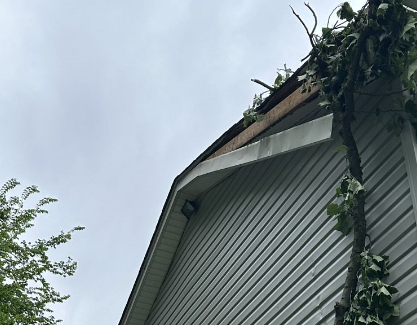Ultimate Guide to Eco-Friendly Siding Materials
Discover the top eco-friendly siding materials for your next green building project.
Benefits of Eco-Friendly Siding Materials
Choosing eco-friendly siding materials for your home or building project offers numerous benefits. Some of the key benefits include:
- Reduced environmental impact: Eco-friendly siding materials are made from renewable or recycled resources, reducing the need for new raw materials and minimizing waste.
- Energy efficiency: Many eco-friendly siding materials provide excellent insulation, helping to reduce heating and cooling costs and improve energy efficiency.
- Improved indoor air quality: Unlike traditional siding materials, eco-friendly options do not release harmful chemicals or volatile organic compounds (VOCs) into the air, promoting better indoor air quality.
- Durability and longevity: Eco-friendly siding materials are often designed to be highly durable, resistant to pests, rot, and weather damage, resulting in a longer lifespan for your siding.
- Aesthetically pleasing: With a wide variety of eco-friendly siding options available, you can choose materials that complement your design preferences and enhance the overall aesthetic of your property.
By opting for eco-friendly siding materials, you can create a sustainable and environmentally responsible building envelope for your home or project.
Popular Eco-Friendly Siding Options
When it comes to eco-friendly siding materials, there are several popular options to consider. Some of the most commonly used materials include:
- Recycled wood and reclaimed timber: By using salvaged or recycled wood, you can reduce the demand for new timber and minimize deforestation. This option adds a rustic and natural look to your property.
- Fiber cement: Made from a blend of cement, sand, and cellulose fibers, fiber cement siding is durable, fire-resistant, and low maintenance. It can resemble wood, stucco, or masonry.
- Metal siding: Metal siding, such as aluminum or steel, is highly durable, recyclable, and can be finished with eco-friendly coatings. It offers a modern and sleek appearance.
- Composite siding: Composite siding is made from a combination of recycled wood fibers and plastic. It offers the look of wood without the maintenance requirements and is resistant to rot and insects.
These are just a few examples of eco-friendly siding materials, and each option has its own unique features and benefits. Consider your specific needs and preferences when choosing the right material for your project.
Factors to Consider When Choosing Eco-Friendly Siding
Selecting the right eco-friendly siding material involves considering several factors. Here are some key factors to keep in mind:
- Climate suitability: Different siding materials perform better in certain climates. Consider the weather conditions in your area and choose a material that can withstand the local climate and temperature fluctuations.
- Maintenance requirements: Some eco-friendly siding materials require more maintenance than others. Determine how much time and effort you are willing to invest in maintaining your siding and choose a material accordingly.
- Cost: Eco-friendly siding materials can vary significantly in terms of cost. Consider your budget and weigh the upfront cost against the long-term benefits and durability of the material.
- Aesthetics: The appearance of your siding plays a significant role in the overall look of your property. Choose a material that aligns with your design preferences and complements the architectural style of your home or building.
- Environmental impact: While all eco-friendly siding materials are more sustainable than traditional options, some materials have a lower environmental impact than others. Consider factors such as the material's carbon footprint, recyclability, and biodegradability.
- By carefully considering these factors, you can choose an eco-friendly siding material that meets your needs and aligns with your sustainability goals.
- Installation and Maintenance of Eco-Friendly Siding
- Proper installation and maintenance are crucial for maximizing the performance and longevity of your eco-friendly siding. Here are some tips:
- Hire a professional: To ensure the proper installation of your siding, it's recommended to hire a professional contractor with experience in working with eco-friendly materials.
- Follow manufacturer guidelines: Each siding material has specific installation instructions provided by the manufacturer. It's important to follow these guidelines to ensure proper installation and prevent any potential issues.
- Regular cleaning: Depending on the material, your eco-friendly siding may require regular cleaning to remove dirt, debris, and mildew. Follow the manufacturer's recommendations for cleaning methods and frequency.
- Inspect for damage: Periodically inspect your siding for any signs of damage, such as cracks, warping, or discoloration. Promptly address any issues to prevent further damage and maintain the integrity of your siding.
- Repairs and replacements: If any damage occurs, contact a professional to assess the extent of the damage and determine if repairs or replacements are necessary. Prompt action can prevent more extensive and costly repairs down the line.
By following these installation and maintenance tips, you can ensure that your eco-friendly siding remains in optimal condition and continues to provide the desired benefits for years to come.
Cost Comparison of Eco-Friendly vs. Traditional Siding Materials
One common concern when considering eco-friendly siding materials is the cost. While eco-friendly options may have a higher upfront cost compared to traditional siding materials, it's important to consider the long-term savings and benefits they offer.
Here are some points to consider when comparing the costs:
- Energy efficiency: Eco-friendly siding materials with superior insulation properties can help reduce heating and cooling costs over time, resulting in potential energy savings.
- Maintenance and durability: Eco-friendly siding materials are often designed to be more durable and long-lasting, reducing the need for frequent repairs or replacements and saving on maintenance costs.
- Environmental impact: By choosing eco-friendly siding materials, you contribute to a more sustainable future and reduce the negative environmental impact associated with traditional siding materials.
While the initial investment may be higher, the long-term benefits and cost savings of eco-friendly siding materials make them a worthwhile investment for those concerned about sustainability and energy efficiency.
When comparing costs, it's essential to consider both the short-term and long-term financial implications, as well as the environmental and energy-saving benefits of eco-friendly siding materials.

